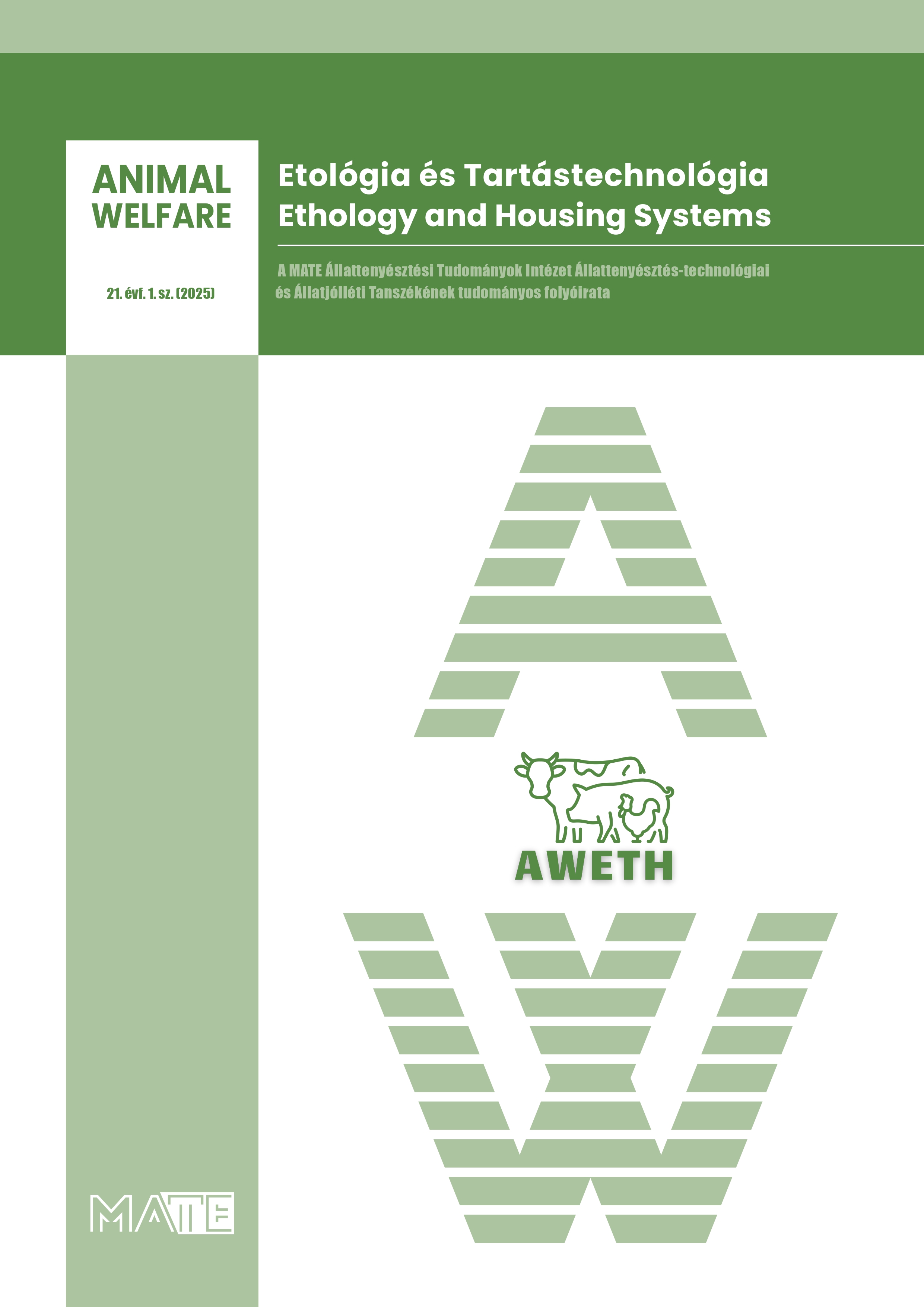Smooth muscle electromyographic measurements with pigs in a stress model
DOI:
https://doi.org/10.17205/aweth.7053Kulcsszavak:
pig, electromyography, smooth muscle, stressAbsztrakt
Stress adversely affects physiological processes in animals, including gastrointestinal motility, potentially reducing digestion efficiency. Electromyography (EMG) is a suitable method for monitoring smooth muscle activity, allowing separate measurements of the heart and digestive organs (stomach, small intestine, large intestine). This study aimed to investigate whether stress alters the smooth muscle activity of the digestive tract using electromyographic measurements. We conducted the experiment on Topigs x Duroc barrows (n = 4), weighing 30 kg. Stress induction was performed with a single intravenous ACTH injection (10 µg/kg), which dose corresponds to a mild stress effect. Electromyographic signals were continuously recorded for 8 hours both in control and stress conditions. The measurements were divided into 30-minute intervals, and the smooth muscle electric potential (mV) was determined for each organ. Statistical comparisons between control and stress-induced states were made using paired Student's t-test. The results revealed a post-stress reduction in smooth muscle activity across all organs. The decrease was statistically significant in the small and large intestine, while in the stomach, reduced activity was observed 5 hours after stress induction. In conclusion, even mild stress decreases the smooth muscle activity of digestive organs, reducing gastrointestinal motility and potentially impairing digestion efficiency.
Hivatkozások
Alvarez, W. C. (1922): The electrogastrogram and what it shows. Journal of American Medical Association, 78, 1116–1118. http://doi.org/10.1001/jama.1922.02640680020008
Bures, J., Kvetina, J., Radochova, V., Tacheci, I., Peterova, E., Herman, D., Dolezal, R., Kopacova, M., Rejchrt, S., Douda, T., Sestak, V., Douda, L., Karasova, J. Z. (2020): The pharmacokinetic parameters and the effect of a single and repeated doses of memantine on gastric myoelectric activity in experimental pigs. Plos One. 15(1), e0227781. https://doi.org/10.1371/journal.pone.0227781.
Bures, J., Kvetina, J., Pavlik, M., Kunes, M., Kopacova, M., Rejchrt, S., Jun, D., Hrabinova, M., Kuca, K., Tachecí, I. (2013): Impact of paraoxon followed by acetylcholinesterase reactivator HI-6 on gastric myoelectric activity in experimental pigs. Neuroendocrinology Letters, 34 Suppl 2, 79–83. 24362097
Fonyó, A. (2011): Az orvosi élettan tankönyve. Medicina Könyvkiadó Zrt. 708 p.
Martens, B. M. J., Noorloos, M., de Vries, S., Schols, H. A., Bruininx, E. M. A. M., Gerrits, W. J. J. (2019): Whole digesta properties as influenced by feed processing explain variation in gastrointestinal transit times in pigs. The British Journal of Nutrition, 122(11), 1242–1254. https://doi.org/10.1017/S0007114519002198
Nagy, K., Fébel, H., Bazar, G., Grosz, G., Gáspár, R., Szűcs, F. K., Tóth, T. (2021): Non-invasive smooth muscle electromyography (SMEMG) as a novel monitoring technology of the gastrointestinal tract of awake, free-moving pigs-A pilot study. PloS One, 16(9), e0257311. https://doi.org/10.1371/journal.pone.0257311
Pribék, I. K., Szűcs, K. F., Süle, M., Grosz, G., Ducza, E., Vigh, D., Tóth, E., Janka, Z., Kálmán, J., Datki, Z. L., Gáspár, R., Andó, B. (2021): Detection of acute stress by smooth muscle electromyography: A translational study on rat and human. Life sciences, 277, 119492. https://doi.org/10.1016/j.lfs.2021.119492
Sanders, K. M., Koh, S. D., Ward, S. M. (2006): Interstitial cells of cajal as pacemakers in the gastrointestinal tract. Annual review of physiology, 68, 307–343. https://doi.org/10.1146/annurev.physiol.68.040504.094718
Sciascia, Q. L., Metges, C. C. (2023): Review: Methods and biomarkers to investigate intestinal function and health in pigs. Animal : an international journal of animal bioscience, 17 Suppl 3, 100860. https://doi.org/10.1016/j.animal.2023.100860
Smulders, D., Verbeke, G., Mormède, P., Geers, R. (2006): Validation of a behavioral observation tool to assess pig welfare. Physiology & Behavior, 89(3), 438–447. https://doi.org/10.1016/j.physbeh.2006.07.002
Szűcs, K. F., Grosz, G., Süle, M., Sztojkov-Ivanov, A., Ducza, E., Márki, A., Kothencz, A., Balogh, L., Gáspár, R. (2018): Detection of stress and the effects of central nervous system depressants by gastrointestinal smooth muscle electromyography in wakeful rats. Life sciences, 205, 1–8. https://doi.org/10.1016/j.lfs.2018.05.015
Wilfart, A., Montagne, L., Simmins, H., Noblet, J., Van Milgen, J. (2007): Effect of fibre content in the diet on the mean retention time in different segments of the digestive tract in growing pigs. Livestock Science, 109, 27–29. https://doi.org/10.1016/j.livsci.2007.01.032
Letöltések
Megjelent
Folyóirat szám
Rovat
License
Copyright (c) 2025 Csötönyi Orsolya, Béres Gabriella, Halas Veronika

This work is licensed under a Creative Commons Attribution-NonCommercial-NoDerivatives 4.0 International License.
A folyóirat a nyílt hozzáférés elvei szerint működik, cikkeire ugyanakkor a Creative Commons 4.0 standard licenc alábbi típusa vonatkozik: CC-BY-NC-ND-4.0. Ennek értelmében a mű szabadon másolható, terjeszthető, bemutatható és előadható, azonban nem használható fel kereskedelmi célokra (NC), továbbá nem módosítható és nem készíthető belőle átdolgozás, származékos mű (ND). A licenc alapján a szerző vagy a jogosult által meghatározott módon fel kell tüntetni a szerző nevét és a szerzői mű címét (BY).














